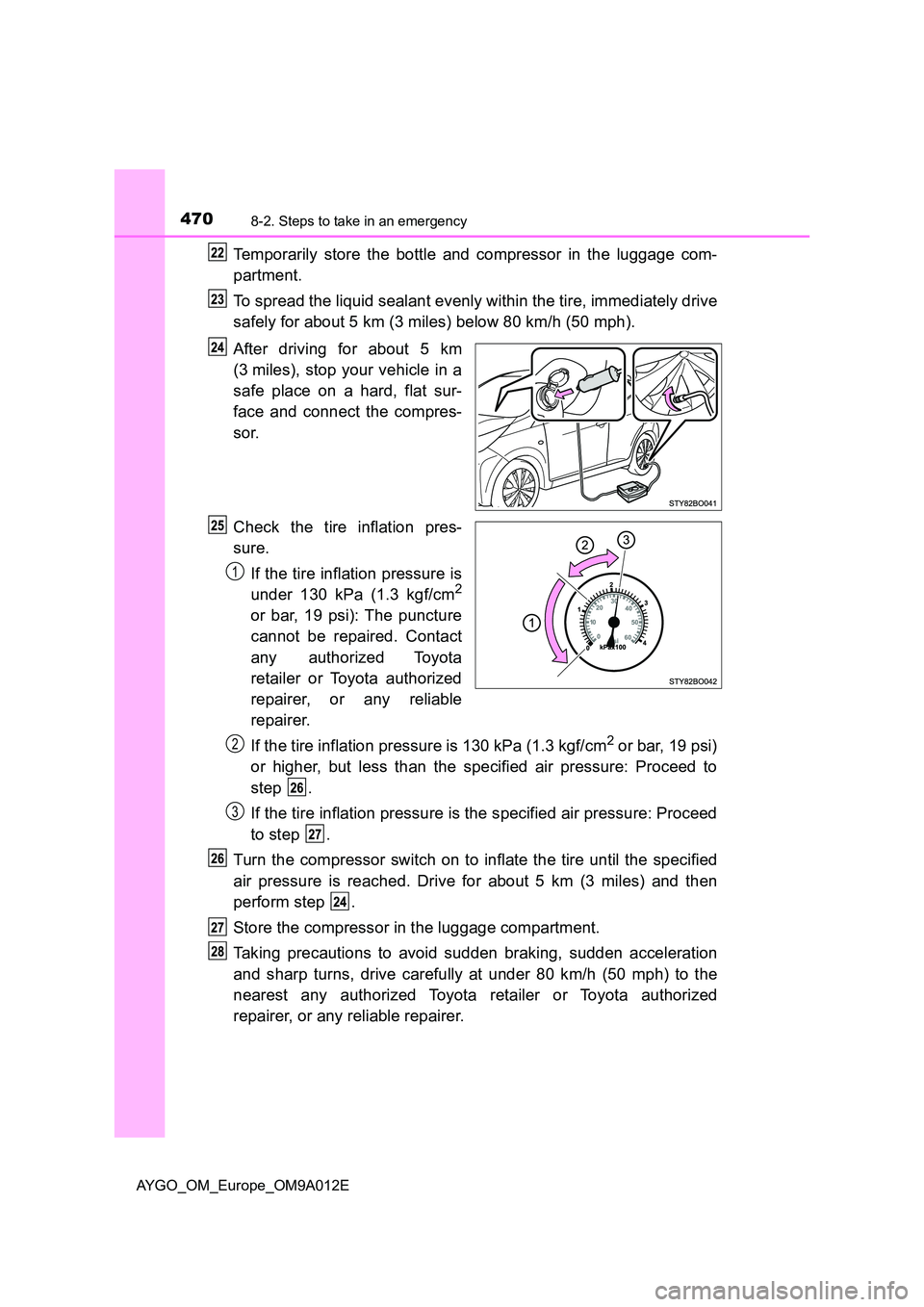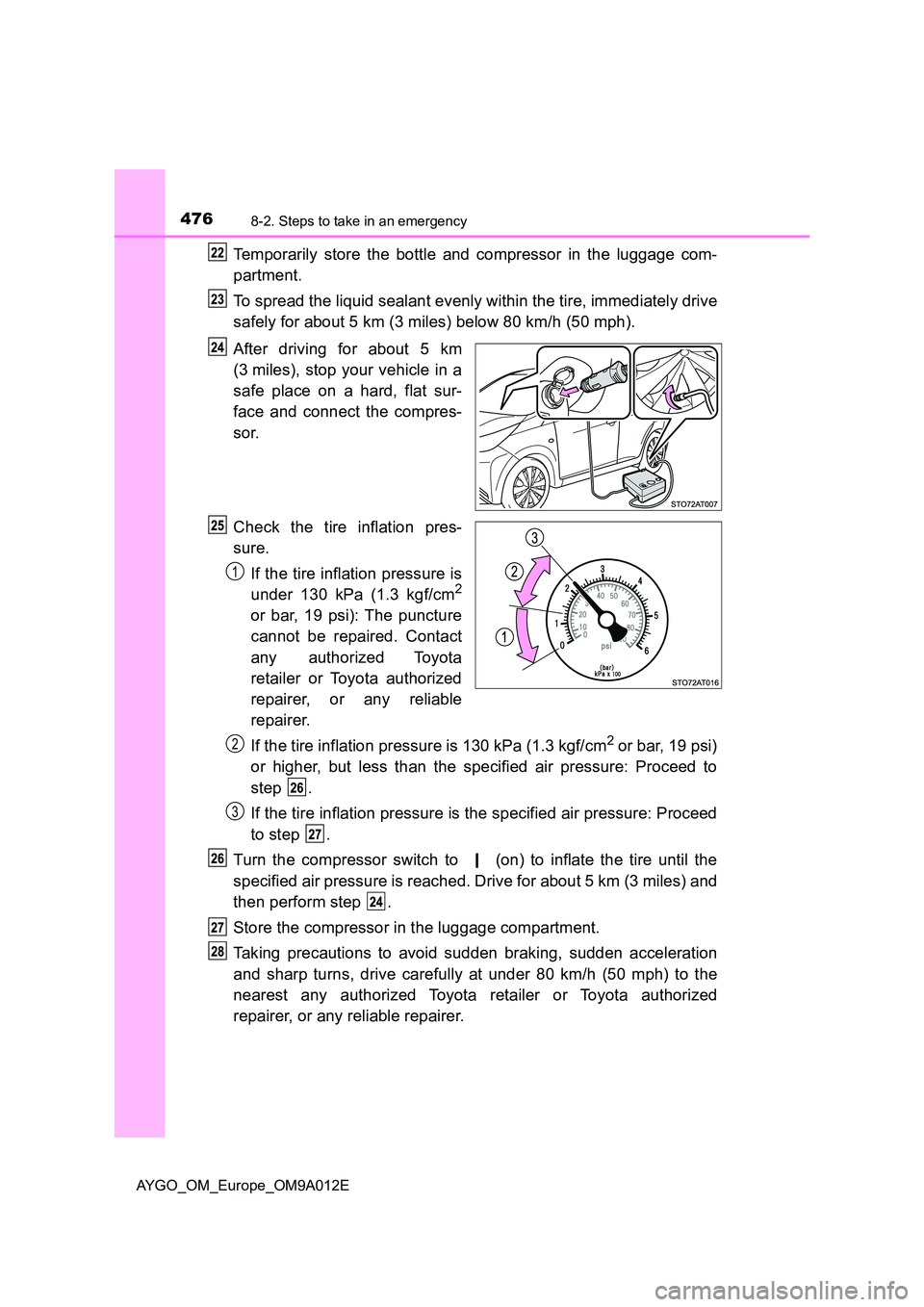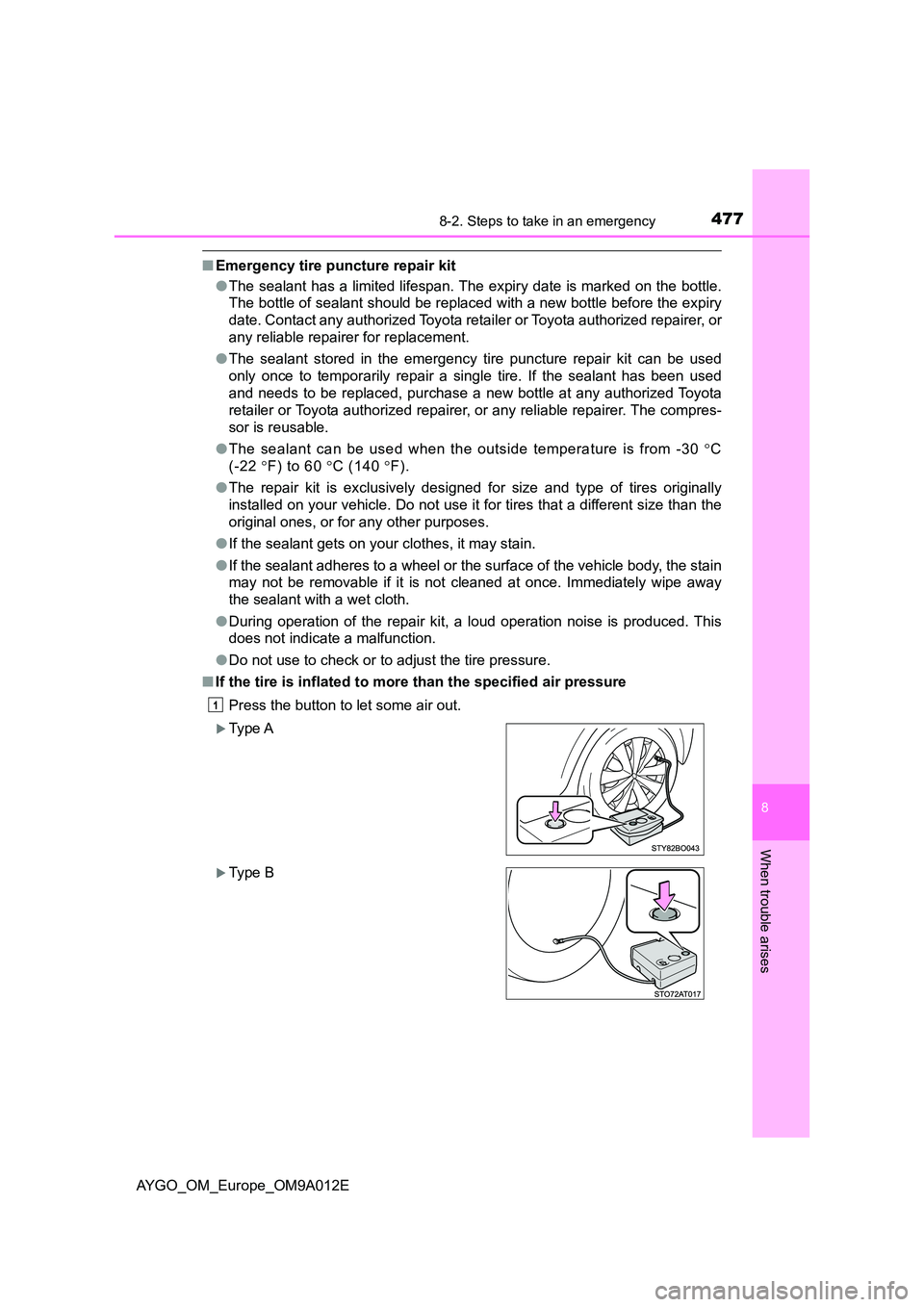Page 462 of 546

4608-2. Steps to take in an emergency
AYGO_OM_Europe_OM9A012E
●Stop the vehicle in a safe place on a hard, flat surface.
● Set the parking brake.
● Shift the shift lever to N.
● Stop the engine.
● Turn on the emergency flashers. (P. 438)
● Check the degree of the tire damage.
A tire should only be repaired with
the emergency tire puncture
repair kit if the damage is caused
by a nail or screw passing through
the tire tread.
• Do not remove the nail or screw
from the tire. Removing the
object may widen the opening
and prevent emergency repair
with the repair kit.
• To avoid sealant leakage, move the vehicle until the area of the
puncture, if known, is positioned at the top of the tire.
■ A flat tire that cannot be repaired with the emergency tire puncture repair
kit
In the following cases, the tire c annot be repaired with the emergency tire
puncture repair kit. Contact any authorized Toyota retailer or Toyota autho-
rized repairer, or any reliable repairer.
● When the tire is damaged due to driving without sufficient air pressure
● When the tire lost air pressure due to a crack or damage in the tire sidewall
● When the tire is visibly separated from the wheel
● When the cut or damage to the tread is 4 mm (0.16 in.) long or more
● When the wheel is damaged
● When two or more tires have been punctured
● When there is more than one hole or cut in the damaged tire
● When the sealant has expired
Before repairing the vehicle
Page 469 of 546
4678-2. Steps to take in an emergency
8
When trouble arises
AYGO_OM_Europe_OM9A012E
Make sure that the compressor
switch is off.
Remove the power plug from
the compressor.
Connect the power plug to the
power outlet socket. ( P. 376)
Check the specified tire inflation
pressure.
Tire inflation pressure is specified
on the label as shown. ( P. 518)
Start the engine. (P. 214, 217)
Page 470 of 546
4688-2. Steps to take in an emergency
AYGO_OM_Europe_OM9A012E
To inject the sealant and inflate
the tire, turn the compressor
switch on.
Inflate the tire until the specified
air pressure is reached.
The sealant will be injected
and the pressure will surge
and then gradually
decrease.
The air pressure gauge will
display the actual tire infla-
tion pressure about 1 minute
(5 minutes at low tempera-
ture) after the switch is
turned on.
Inflate to specified air pres-
sure.
• If the tire inflation pressure is still lower than the specified point after
inflation for 35 minutes with the switch on, the tire is too damaged to
be repaired. Turn the compressor switch off and contact any autho-
rized Toyota retailer or Toyota authorized repairer, or any reliable
repairer.
• If the tire inflation pressure exceeds the specified air pressure, let out
some air to adjust the tire inflation pressure. ( P. 477, 518)
1
2
3
Page 472 of 546

4708-2. Steps to take in an emergency
AYGO_OM_Europe_OM9A012E
Temporarily store the bottle and compressor in the luggage com-
partment.
To spread the liquid sealant evenly within the tire, immediately drive
safely for about 5 km (3 miles) below 80 km/h (50 mph).
After driving for about 5 km
(3 miles), stop your vehicle in a
safe place on a hard, flat sur-
face and connect the compres-
sor.
Check the tire inflation pres-
sure.
If the tire inflation pressure is
under 130 kPa (1.3 kgf/cm2
or bar, 19 psi): The puncture
cannot be repaired. Contact
any authorized Toyota
retailer or Toyota authorized
repairer, or any reliable
repairer.
If the tire inflation pressure is 130 kPa (1.3 kgf/cm2 or bar, 19 psi)
or higher, but less than the specified air pressure: Proceed to
step .
If the tire inflation pressure is the specified air pressure: Proceed
to step .
Turn the compressor switch on to inflate the tire until the specified
air pressure is reached. Drive for about 5 km (3 miles) and then
perform step .
Store the compressor in the luggage compartment.
Taking precautions to avoid sudden braking, sudden acceleration
and sharp turns, drive carefully at under 80 km/h (50 mph) to the
nearest any authorized Toyota retailer or Toyota authorized
repairer, or any reliable repairer.
1
2
3
Page 475 of 546
4738-2. Steps to take in an emergency
8
When trouble arises
AYGO_OM_Europe_OM9A012E
Make sure that the compressor
switch is (off).
Remove the power plug from
the compressor.
Connect the power plug to the
power outlet socket. ( P. 376)
Check the specified tire inflation
pressure.
Tire inflation pressure is specified
on the label as shown. ( P. 518)
Start the engine. (P. 214, 217)
Page 476 of 546
4748-2. Steps to take in an emergency
AYGO_OM_Europe_OM9A012E
To inject the sealant and inflate
the tire, turn the compressor
switch to (on).
Inflate the tire until the specified
air pressure is reached.
The sealant will be injected
and the pressure will surge
and then gradually
decrease.
The air pressure gauge will
display the actual tire infla-
tion pressure about 1 minute
(5 minutes at low tempera-
ture) after the switch is
turned (on).
Inflate to specified air pres-
sure.
• If the tire inflation pressure is still lower than the specifi ed point after
inflation for 35 minutes with the switch at (on), the tire is too
damaged to be repaired. Turn the compressor switch to (off) and
contact any authorized Toyota retailer or Toyota authorized rep airer,
or any reliable repairer.
• If the tire inflation pressure exceeds the specified air press ure, let out
some air to adjust the tire inflation pressure. ( P. 477, 518)
1
2
3
Page 478 of 546

4768-2. Steps to take in an emergency
AYGO_OM_Europe_OM9A012E
Temporarily store the bottle and compressor in the luggage com-
partment.
To spread the liquid sealant evenly within the tire, immediatel y drive
safely for about 5 km (3 miles) below 80 km/h (50 mph).
After driving for about 5 km
(3 miles), stop your vehicle in a
safe place on a hard, flat sur-
face and connect the compres-
sor.
Check the tire inflation pres-
sure.
If the tire inflation pressure is
under 130 kPa (1.3 kgf/cm2
or bar, 19 psi): The puncture
cannot be repaired. Contact
any authorized Toyota
retailer or Toyota authorized
repairer, or any reliable
repairer.
If the tire inflation pressure is 130 kPa (1.3 kgf/cm2 or bar, 19 psi)
or higher, but less than the specified air pressure: Proceed to
step .
If the tire inflation pressure is the specified air pressure: P roceed
to step .
Turn the compressor switch to (on) to inflate the tire until the
specified air pressure is reached. Drive for about 5 km (3 mile s) and
then perform step .
Store the compressor in the luggage compartment.
Taking precautions to avoid sudden braking, sudden acceleration
and sharp turns, drive carefully at under 80 km/h (50 mph) to t he
nearest any authorized Toyota retailer or Toyota authorized
repairer, or any reliable repairer.
1
2
3
Page 479 of 546

4778-2. Steps to take in an emergency
8
When trouble arises
AYGO_OM_Europe_OM9A012E
■Emergency tire puncture repair kit
● The sealant has a limited lifespan. The expiry date is marked on the bottle.
The bottle of sealant should be replaced with a new bottle before the expiry
date. Contact any authorized Toyota retailer or Toyota authorized repairer, or
any reliable repairer for replacement.
● The sealant stored in the emergency tire puncture repair kit can be used
only once to temporarily repair a single tire. If the sealant has been used
and needs to be replaced, purchase a new bottle at any authorized Toyota
retailer or Toyota authorized repairer, or any reliable repairer. The compres-
sor is reusable.
● The sealant can be used when the outside temperature is from -30 C
(-22 F) to 60 C (140 F).
● The repair kit is exclusively designed for size and type of tires originally
installed on your vehicle. Do not use it for tires that a different size than the
original ones, or for any other purposes.
● If the sealant gets on your clothes, it may stain.
● If the sealant adheres to a wheel or the surface of the vehicle body, the stain
may not be removable if it is not cleaned at once. Immediately wipe away
the sealant with a wet cloth.
● During operation of the repair kit, a loud operation noise is produced. This
does not indicate a malfunction.
● Do not use to check or to adjust the tire pressure.
■ If the tire is inflated to more than the specified air pressure
Press the button to let some air out.
Type A
Type B